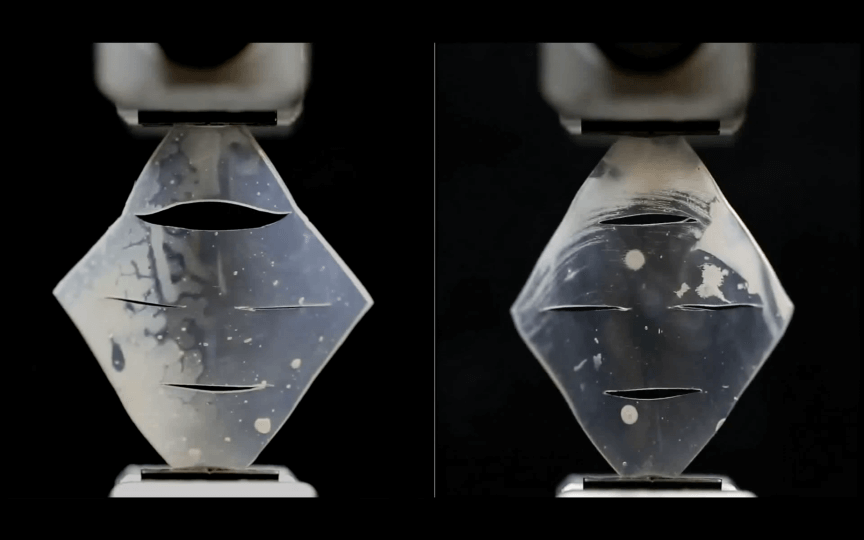By raising the fatigue threshold of particle-reinforced rubber, researchers from the Harvard John A. Paulson School of Engineering and Applied Sciences (SEAS) have created a novel, multiscale method that enables the material to support heavy loads and withstand the formation of cracks over time.

SEAS researchers have developed a multiscale approach that allows particle-reinforced rubber to bear high loads and resist crack growth over repeated use. Above, cracks grow in the left sample while the cracks in the right sample, made from the multiscale material, remain intact after 350,000 cycles. Image Credit: Suo Group/Harvard SEAS
This strategy could extend the life of rubber goods like tires while lowering the quantity of pollutants produced by rubber particles shed during use.
The research is published in Nature.
Rubber latex that occurs naturally is pliable and flexible. Rubbers are reinforced with stiff particles like silica and carbon black for various uses, such as dampers, hoses, and tires.
Since they were introduced, these particles have significantly increased rubbers' stiffness. However, they have not enhanced the material's fatigue threshold—the ability to withstand the formation of cracks when the material is repeatedly stretched.
Particle-reinforced rubbers’ fatigue threshold has not increased much since it was originally studied in the 1950s. This means that despite tire innovations that reduce fuel consumption and increase wear resistance, minor fractures can release enormous volumes of rubber particles into the environment, which clog rivers and streams and pollute human air.
By extending polymer chains and densifying entanglements, a group under the direction of Zhigang Suo, the Allen E. and Marilyn M. Puckett Professor of Mechanics and Materials at SEAS, significantly raised the fatigue threshold of rubbers in earlier studies. What about rubbers reinforced with particles?
The researchers thought that adding silica particles to highly entangled rubber could improve stiffness without affecting fatigue threshold, as is typically shown in the literature. The researchers were wrong.
We did not expect adding particles would increase the fatigue threshold but we discovered that it increased by a factor of ten.
Jason Steck, Co-first Author, Former Graduate Student, John A. Paulson School of Engineering and Applied Sciences, Harvard University
Steck is now a Research Engineer at GE Aerospace.
The material created by the Harvard researchers has lengthy, highly entangled polymer chains with particles that are covalently bound to each other in clusters.
As it turns out this material deconcentrates stress around a crack over two length scales: the scale of polymer chains, and the scale of particles. This combination stops the growth of a crack in the material.
JunsooKim, Study Co-Author and Former Graduate Student, John A. Paulson School of Engineering and Applied Sciences, Harvard University
Kim is now an Assistant Professor of Mechanical Engineering at Northwestern University.
The group carved a crack in a sample of their material, then stretched it tens of thousands of times to show off their method. The crack never expanded in their experiments.
Our approach of multiscale stress deconcentration expands the space of material properties, opening doors to curtailing polymer pollution and building high-performance soft machines.
Zhigang Suo, Senior Author, John A. Paulson School of Engineering and Applied Science, Harvard University
Yakov Kutsovsky, Co-author, Expert, Residence, Harvard Office of Technology Development, added, “Traditional approaches to design new elastomeric materials missed these critical insights of using multiscale stress deconcentration to achieve high performance elastomeric materials for broad industrial uses. Design principles developed and demonstrated in this work could be applicable across a wide range of industries, including high-volume applications such as tires and industrial rubber goods, as well as emerging applications such as wearable devices.”
Kutsovsky served as Chief Scientific Officer and Chief Technology Officer at Cabot Corporation for 15 years.
Harvard’s Office of Technology Development has secured the intellectual property related to this project and is exploring commercialization opportunities.
The MRSEC grant DMR-2011754 and the Air Force Office of Scientific Research partly supported the research under grant FA9550-20-1-0397.
Journal Reference:
Steck, J., et al. (2023). Multiscale stress deconcentration amplifies fatigue resistance of rubber. Nature. doi/s41586-023-06782-2